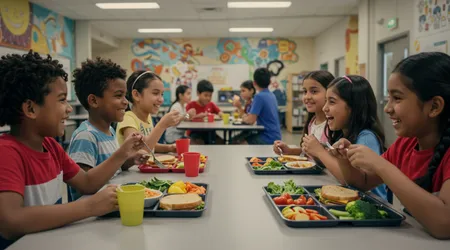National School Food Program: What the $1B Investment Means for Canadian Kids

The National School Food Program, announced in 2024, marks a historic commitment to nourish Canada’s future.
With a $1 billion investment over five years, this initiative aims to feed 400,000 more children annually, addressing food insecurity and fostering healthier generations.
As grocery costs soar, one in four Canadian kids faces hunger, impacting their health and learning. This program, backed by federal, provincial, and territorial collaboration, promises to transform school food environments.
But what does it truly mean for Canadian kids? Let’s explore how this investment reshapes nutrition, education, and equity.
Canada’s children deserve a strong start. The National School Food Program tackles a pressing issue: food insecurity affects 2.1 million kids, limiting their potential.
By expanding access to nutritious meals, the program supports academic success and long-term health. It’s not just about food it’s about fairness, opportunity, and building a culture of wellness.
This article dives into the program’s benefits, from classroom focus to economic ripple effects, and why it’s a game-changer for families.
Nourishing Minds: The Link Between Food and Learning
Hunger clouds the mind. A 2023 University of Toronto study found that well-fed students show improved focus and academic performance.
The National School Food Program delivers meals to kids who might otherwise skip breakfast or lunch. This fuels better concentration, engagement, and problem-solving in classrooms across Canada.
Imagine a third-grader, Sarah, arriving at school hungry, unable to focus on math. A nutritious breakfast from the program changes her day.
++ Canada Dental Care Plan Expands: What It Means for Families in 2025
She listens, learns, and thrives. Schools in British Columbia already report higher attendance when meals are provided. By removing hunger as a barrier, the program unlocks kids’ potential.
Beyond immediate focus, consistent nutrition shapes lifelong habits. Kids eating balanced school meals are more likely to choose healthy foods as adults.
The National School Food Program isn’t just feeding kids today it’s teaching them to value nutrition for tomorrow.

Breaking the Stigma: Universal Access for All
Food programs often carry stigma. Targeted initiatives can make kids feel singled out, discouraging participation.
The National School Food Program champions universal access, offering meals to all students in participating schools. This reduces shame and ensures no child feels “less than” for needing a meal.
Take Michael, a middle schooler in Saskatchewan. His family struggles, but pride keeps him from free lunch programs.
Also read: Middle‑Income Tax Cut 2025: How Much You’ll Save and When
A universal model lets him eat without judgment. By 2025, all provinces and territories had signed agreements to roll out this approach. Equity in access means equity in opportunity.
This inclusivity also fosters community. Shared meals build social bonds, teaching kids to connect over food.
The program’s design ensures every child, regardless of background, benefits from nutritious meals, leveling the playing field.
Economic Ripple Effects: Supporting Families and Communities
Feeding kids saves families money. Amberley Ruetz, a University of Saskatchewan researcher, estimates school meal programs save families $190 per child monthly.
The National School Food Program eases financial burdens, especially for low-income households facing rising grocery costs.
Local economies benefit too. The Liberal Party’s 2025 platform pledged funding for “Buy Canadian” in school food programs, boosting farmers and suppliers.
In Nova Scotia, local produce in school meals supports nearby growers. This creates jobs and strengthens food systems.
Read more: National School Food Program: What the $1B Investment Means for Canadian Kids
The program also sparks long-term gains. Well-nourished kids perform better, leading to higher future earnings. This economic boost reduces reliance on social services, creating a cycle of prosperity that starts with a simple meal.
Cultural and Local Adaptation: Respecting Diversity
Canada’s diversity demands flexible food programs. The National School Food Program allows provinces and territories to tailor menus to local cultures and preferences. In Inuit Nunangat, $36 million over three years funds culturally relevant meals for 75 schools.
For example, a Toronto school might serve halal options for Muslim students, while a Manitoba school includes Indigenous ingredients like wild rice.
This respects dietary needs and teaches kids about their heritage. Flexible funding ensures meals reflect community identities.
However, challenges remain. Some schools lack kitchens or volunteers to prepare culturally appropriate foods. The program’s success hinges on addressing these gaps to ensure every child feels seen and nourished.
Healthier Futures: Long-Term Impacts on Well-Being
Poor diets in childhood lead to lifelong health issues. The National School Food Program aligns with Canada’s Food Guide, prioritizing nutritious, whole foods.
This reduces risks of obesity, diabetes, and heart disease, which burden healthcare systems.
In 2024, British Columbia invested $214 million over three years in school meals, reporting lower rates of childhood obesity in participating schools.
By providing balanced meals, the program sets kids up for healthier adulthoods. It’s like planting a seed for a stronger, healthier Canada.
Yet, nutritional quality varies. Some programs rely on processed foods due to budget constraints. The federal investment must prioritize fresh, high-quality ingredients to maximize health benefits for kids.
Building Sustainable Systems: Infrastructure and Research

Effective school food programs need infrastructure. In 2024, $20.2 million was allocated for kitchen equipment and facilities through the School Food Infrastructure Fund.
This ensures schools can prepare and serve meals efficiently, sustaining the program long-term.
Research also drives success. Employment and Social Development Canada and the Canadian Institutes of Health Research launched a $1.3 million grant in 2025 to study program impacts. This data will refine delivery, ensuring meals meet kids’ needs effectively.
Sustainability requires community buy-in. Schools engaging students in meal prep, like gardening clubs in Ontario, foster ownership. These efforts make the program a lasting part of Canada’s education system.
Challenges and Opportunities: Making It Work
No program is without hurdles. Many schools lack adequate kitchens, limiting meal quality. Volunteer shortages also strain delivery. The National School Food Program must address these to reach all 400,000 targeted kids.
Engaging communities is key. In Yukon, local partnerships with food banks enhance program reach. Collaboration with Indigenous groups ensures culturally relevant meals, but more investment is needed to scale these efforts nationwide.
Why settle for patchwork solutions? A well-funded, universal program can transform schools into hubs of health and equity. The $1 billion investment is a start, but ongoing commitment will determine its success.
The Data Behind the Impact
The table below highlights key investments and outcomes of the National School Food Program as of 2025, based on government and coalition reports:
| Region | Federal Funding (2024-2029) | Additional Kids Served | Key Outcome |
|---|---|---|---|
| British Columbia | $39.4M over 3 years | 50,000 | Enhanced school meal programs |
| Saskatchewan | $15.8M over 3 years | 30,000 | Reduced food insecurity in rural areas |
| Inuit Nunangat | $36M over 3 years | 10,000 | Culturally relevant meals implemented |
| National Total | $1B over 5 years | 400,000 | Improved academic and health outcomes |
This data underscores the program’s reach and potential. By 2025, all provinces and territories had signed agreements, ensuring nationwide impact.
A Vision for the Future
The National School Food Program is more than meals it’s a promise to Canada’s kids. It’s a bridge to equity, health, and opportunity.
Like a lighthouse guiding ships, it offers direction for a generation navigating challenges. By addressing hunger, stigma, and economic strain, it lays a foundation for brighter futures.
Yet, the journey is just beginning. Sustained funding, infrastructure, and research are critical to its success. Canada is the only G7 nation without a permanent school food program let’s make this one permanent. Families, communities, and kids deserve nothing less.
Frequently Asked Questions
1. Who qualifies for the National School Food Program?
All students in participating schools can access meals, regardless of income, to reduce stigma and ensure universal access.
2. How are meals tailored to cultural needs?
Provinces and territories adapt menus to reflect local cultures, like halal options in Ontario or Indigenous foods in Manitoba.
3. What challenges does the program face?
Key challenges include inadequate kitchen infrastructure, volunteer shortages, and ensuring consistent nutritional quality across diverse regions.
4. How does the program save families money?
By providing free or low-cost meals, it saves families up to $190 per child monthly, easing grocery budget pressures.
5. Will the program become permanent?
The Liberal Party’s 2025 platform promised permanence, but legislation is needed to embed it in law, as advocated by the Coalition for Healthy School Food.
